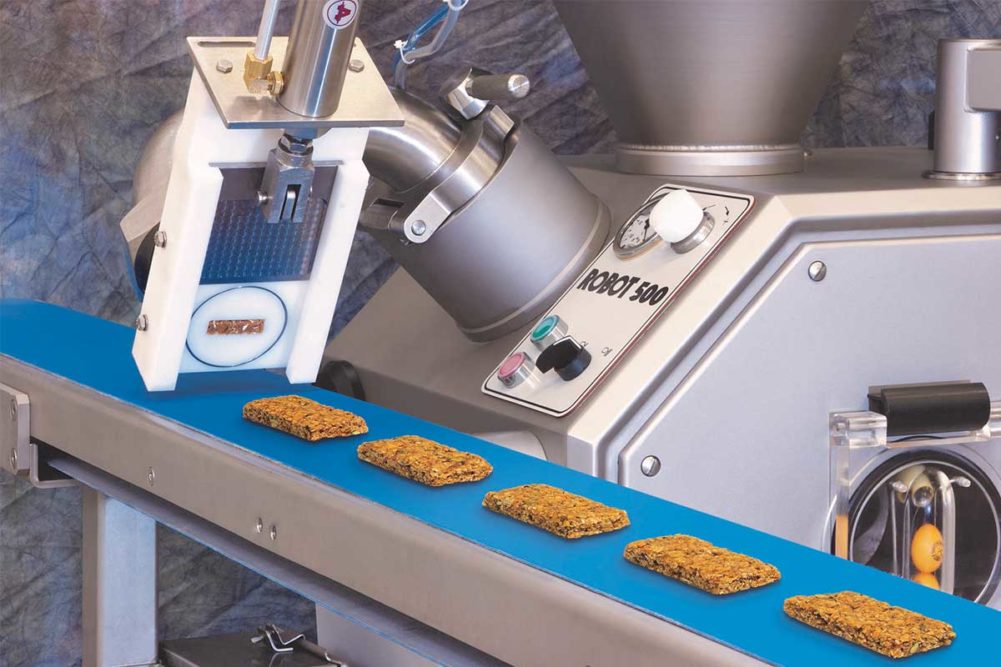In the battle for share of stomach, cookies and bars play the category crossover game better than any other products.
Cookies can be everything from gluten-free and no-added-sugar healthful snacks to ooey-gooey, nutty and chocolaty gourmet options that dare to contend in the broader dessert category.
Snack, nutritional and granola bars also battle it out with cookies in the grab-and-go arena while providing energy-generating, protein-filled or other better-for-you alternatives to on-the-go candy bars, muffins and almost anything else that’s sweet and satisfying.
“Often there’s a thin line between what’s a candy bar and what’s a snack bar, in many cases, especially if it involves enrobing and those type of things,” observed Dan Christie, sales manager, North America, Spooner Vicars Bakery Systems, a Middleby Bakery company.
From a production standpoint, cookies and bars share several processing similarities.
“With some additions, cookie lines can produce baked granola, granola bars, health bars, co-extrusion cookies, encapsulated or filled cookies, rotary moulded cookies, rotary cut cookies, sheeted cookies and cake/brownies,” said Sam Pallottini, director of cookie, cracker and pet food sales, Reading Bakery Systems (RBS).
However, there’s much more to processing them than putting a round cookie into a rectangle shape, and vice versa.
“For baked granola and granola bars, customers can add a simple dough feed system at the beginning of the oven along with a compression style roller while adding a slitter and cutter to the post-oven section,” Mr. Pallottini explained. “For health bars, it could be as simple as supplying a new die and filler block for the wirecut or a bit more evolved using some of the granola equipment.”
For co-extrusion cookies, such as fig bars, the wirecut requires a new head with a larger gap, divider plate, die and filler block. Mr. Pallottini added, however, that bakeries will need to add a pump system for the inner filling while using the current feed system for the outer jacket.
Overall, new products require versatility when it comes to these sweet and sometimes savory snacking sensations.
“The ever-changing nature of the snack industry means that the key to a successful line is flexibility,” said Katie Winkle, sales director, Baker Perkins. “Being able to adapt an existing processing line to accommodate new and innovative products is critical for producers and particularly co-manufacturers, who must be able to adapt quickly to market demands. The easiest way to add product diversity to an existing product line is with modular equipment additions. For example, adding bar cutting, dry ingredient topping, glazing or even jelly-topping capabilities to an existing product line creates a plethora of new possibilities.”
For burgeoning bakeries, the major challenge involves mimicking the production of carefully crafted cookies and bars when automating and scaling up production.
“The challenge for these bakers is to produce the same product using dough depositors that they were producing by hand,” said John McIsaac, vice president, strategic business development, Reiser.
Often, he added, these bakeries don’t have several dedicated lines and need a portioner that can handle multiple viscosities, inclusions and product shapes and sizes.
“Many of our smaller and medium-sized producers use Vemag forming systems for both cookies and bars,” Mr. McIsaac said. “Our ability to quickly swap attachments allows our processors to go from cookies to bars and back again quickly and simply. Being recipe-driven means the Vemag can produce multiple products consistently with a minimum of changeover issues.”
Many processing lines offer other options for quick changeovers.
“As far as different attachments go, such as diverting batter into rows or using different cutting mechanisms, there are change carts where you can disassemble components and put another part on,” said Ken Hagedorn, vice president bakery sector, Handtmann. “If you are talking about a typical cookie or bar, changeover is very simple because of the cleanability of our equipment and the ability to change parts.”
Encapsulated or filled products create additional avenues for new products. Ms. Winkle described Baker Perkins’ TruClean Servo Wirecuts as “encapsulation ready.” Bakeries can add a modular encapsulation system to expand their wirecut processing capabilities to transform traditional cookies and bars into filled snacks without any significant change in the overall footprint of the line.
Mr. Pallottini pointed out that encapsulating or filling cookies follows a similar path as co-extrusion. However, an iris cutter is required to pinch the stream of doughs to encapsulate the inner filling with the outer jacket.
Other processing options, he added, include placing a rotary moulder or rotary cutting system at the oven infeed or sheeting cookies and bars using a wirecut and a special die and filler block.
This article is an excerpt from the April 2022 issue of Baking & Snack. To read the entire feature on Cookie & Bar Processing, click here.





